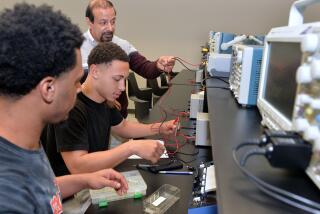Learn From Others’ Trade School Experiences
Congress has begun to take a look at one of the most troubling trends today: private post-secondary schools--particularly trade and technical schools--that go belly up after taking students’ fees but before providing the promised education and job opportunities.
“This sector has been plagued with fly-by-night operators--schools that file bankruptcy or close up in the middle of the night,” says Alan Edelman, counsel for the U.S. Senate permanent subcommittee on investigations.
About 2,000 private trade and technical schools have folded nationwide over the last 10 years, according to the Career College Assn., a Washington, D.C., trade group representing the industry. That’s more than the estimated 1,800 to 1,900 accredited schools currently operating, says Lisa Phillips, association director of government relations.
In California, 87 of these so-called “proprietary” colleges have failed so far this year, says Les Cochren, manager of consumer and student protection at the Council for Private Postsecondary and Vocational Education. More than 300 such schools closed their doors last year, he says.
It’s worth noting that few of the failures are attributed to fraud. In congressional testimony last month, government auditors said fraud contributes to fewer than 10 failures each year. Most experts believe that trade schools are suffering the same kinds of growing pains that hit the health club industry a decade ago. Vast popularity spurs hundreds of schools to open. But inexperienced operators may underestimate the amount of money and the number of students needed to keep the business going.
Congress is looking into the issue because of the waste of taxpayer money involved when federal aid such as Pell Grants goes to pay for schooling at a trade tech that then closes.
The vast majority of trade, technical and “proprietary” schools that go under are for-profit enterprises, and students are expected to pay their tuition fees for each term upfront, before classes even start.
And the students themselves suffer, too, of course. Those who took out student loans to pay for education at a school that then goes under face a particularly cruel situation. They owe money on a loan for something--an education--that they did not get. If they simply do not repay the loan, they ruin their credit ratings and also make themselves ineligible for other federal loans in the future.
Those who paid their tuition in cash may simply be out the money.
“The students are really the biggest losers here,” Edelman says. “They are often at the lowest rung of the economic ladder and see these schools as a way out.”
Adds Cochren: “It’s a devastating experience when a student has gone for two or three years to a school and they wake up one day and it’s gone.”
However, there are some steps someone who ends up in this situation can take.
The federal government started a program last year that allows for legal discharge of student loans under certain circumstances. Many state governments also have launched tuition recovery funds--and those that don’t are in the process of setting up such funds, Phillips notes. In addition, accredited trade schools generally are required to set up what are known as “teach out” arrangements, which allow students to complete their education at a nearby and similar trade schools should the one they’re enrolled in fail.
Here’s how these programs work:
Student loan discharge: If a private college folds while you are still a student--or within 90 days of your dropping out mid-program--you can apply for a discharge of your federally insured student debts. If you completed your schooling--or plan to complete your schooling by transferring your units to another trade college--you cannot qualify for this program. In addition, if you do get your debt discharged, you must agree to provide testimony to help the government should it decide to prosecute the school’s owners.
Teach-outs: Accredited trade schools generally offer teach-outs. The second school will accept the first school’s displaced students for little or no additional cost. Most schools provide information on their teach-out partnerships when students enroll. In some cases, though, a teach-out can be arranged after the fact.
Tuition recovery: Many states, including California, have established tuition recovery programs designed to reimburse students for at least a portion of their tuition after the failure of a private school.
In California, students fill out a form and a representative from the tuition recovery fund will call you and discuss your options for finishing your course of study at another school or getting a refund. If a teach-out is not available--or if the student is so disenchanted by the trade school program that he or she refuses to transfer--the tuition recovery fund will generally refund at least a portion of the current semester’s tuition.
If a similar school will take the student with no additional tuition and the student decides to complete the program, then, of course, there is no recovery payment, Cochren says. Partial payments are made in teach-out situations when the new school requires additional tuition payments.
There is one important caveat: All these safety nets are available only if you are attending a licensed or accredited school. If the school is not licensed with the state or accredited, you can expect to be on your own. It’s wise to check a school’s status before you sign up or pay any fees.
Kathy M. Kristof welcomes comments and suggestions for columns but regrets that she cannot respond individually to letters and phone calls. Write to Personal Finance, Los Angeles Times, Times Mirror Square, Los Angeles, CA 90053, or send a message to [email protected] on the Internet.
More to Read
Sign up for Essential California
The most important California stories and recommendations in your inbox every morning.
You may occasionally receive promotional content from the Los Angeles Times.










